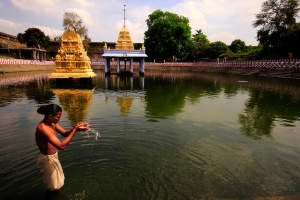Timing of Sandhyavandanam worship
The name suggests Sandhya , the meeting time of Day with night, which is just before and during sunrise and sunset.
‘Ajyotisho darsanat sandhi, jyotisho bhanutare’
The above statement of the shastra means ‘Sandhi is the time when the sun and the stars are together visible’
The practical thing therefore will be to start
- In the morning before sunrise, give Arghyam( explanation later) during sunrise and finish just after sunrise.
- In the evening, begin before sunset, give Arghyam during sunset and finish later.
For those who always are inconsistent with their timings, Shastra says
‘Uttama tarakopeta madhyama lupta taraka
Adhama urya sahita prata: sandhya tridha mana’
To do PrAtha ( morning) sandhyA vandanam when the stars are visible is Uttama (first grade.); Maddhyama (middle grade) when doing without the stars; and Adhama ( least grade when Sun is visible)
“Uttama suryasahita maddhyama anudita taraka
Adhma tarakopeta sayam sandhya tridha mata”
To do Sayam( evening) Sandhya Vandanam , It is Uttama doing while the sun is still shining; Maddhyama when doing before stars are visible; Adhama after the stars are fuly visible.
Sri Abhinava Theertha swamigal says whatever be the grade, it is always best to do it regularly. Otherwise, he warns, one’s Brahmanathva itself is wasted.
The morning and evening sandhis are also ideal since, traditionally and habitually, a person’s stomach will be empty doing both sunrise and sunset. An empty stomach is achieved after four hours of a solid meal. An empty stomach is a prerequisite for Sandhyavandanam since there are at least three sets of pranayama totaling 15 in one full routine. A loaded stomach will interfere with pranayama greatly resulting in indigestion, sleepiness etc. Even the madhyahnikam ( noon) routine is done with an empty stomach before the meal.
There are three types of Karmas- Nithya, Naimithika, and Kamya karmas.
- Kamya karma is one which is done with a desire to achieve, like a yagya for long life etc .Even if kamya karmas are not done , there is no papam.
- Naimithika karma is one which is not shastra bound and not niyamic, i.e., a necessary duty , such as taking bath after an eclipse.
- Nithya karma is one which is ‘niyata nimitta’ meaning ‘ that which is done which is shastra bound’ . Sunrise and sunset are the reason for doing Sandhya vandanam. Hence this is classified in the Nithya karma, which has to be done daily , lifelong.
——————————————
More information about SandhyaVandanam Timings from Viprasamhitha Google group
Tamil Siddhar verse
In tamil there is a sidhar paadal “KAnAmal KonAmal Kandu kodu”
The above statement means :
“Perform prAtassandhyA before seeing the Sun, MAdhyAnhikam when the Sun is right above the head and SAyamsandhyA when the Sun is still not set”.
Sandhya Timings based on Gunas
उपास्ते संधिवेलायां निशायां दिवसस्यच
Morning sandhya and evening sandhyavandana both are timed at sandhi kaala,the meeting of day and night.
When Eshwara created this world,a day was divided into 3 parts.
Satvaguna: Morning 4am to 8am. Afternoon 4pm to night 8pm totalling 8 hours is satvaguna
Rajoguna Morning 8am to afternoon 4pm,again 8 hours
Tamoguna Night 8pm to morning 4am 8 hours
For us,the sleep state is the most relaxing part.But it happens in a tamoguna time.In order to come out of tamoguna,morning sandhyavandana is prescribed between 4am to 8am.If we do gayatri mantra,one gets the blessings of the mantra.
It is still better to do after the satvaguna time to atleast give madhyama results.
taittariya samhitha says अग्निः पूर्वरूपं आदित्य उत्तररूपं
Agni is suryadeva’s first part ,for morning surya is AdhiDevata, for night,Agni is adhidevata
अग्निर्जोति र्ज्योतिरग्नि स्वाहेति सायं जुहोति सुर्योज्योति र्ज्योतिसूर्य स्वाहेति प्रातरिति
Sayam kala is moksharoopa. When a man gets moksha,he gets into sayam sandhya tatva and gets the real gnaana.
Therefore,sayam sandhya is equally very important and has profound basis behind.






0 comments:
Post a Comment
Note: only a member of this blog may post a comment.